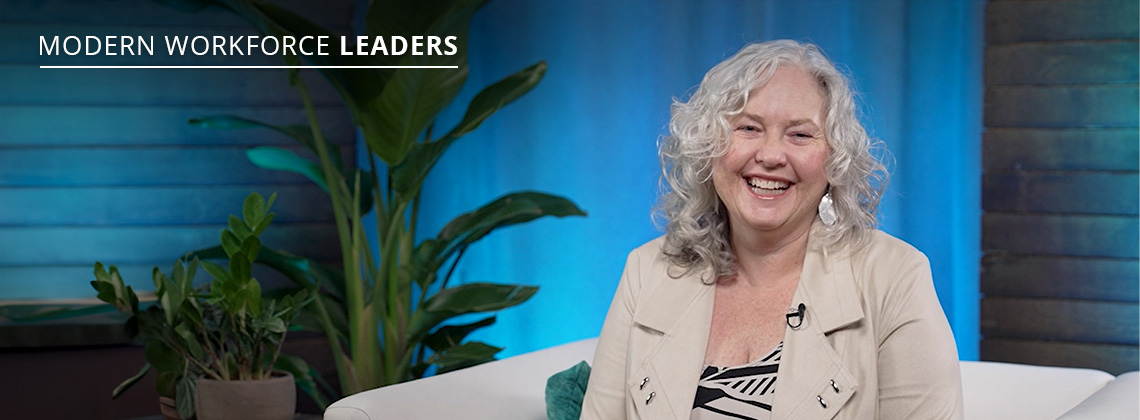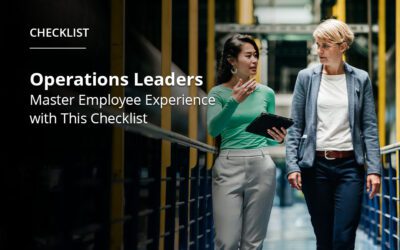Transforming Technology Means Investing in Your Workforce

Achieving effective and impactful workforce management has proven to be a complex and critical challenge for modern organizations. The shift to hybrid work environments along with the substantial rise in employee expectations has pushed today’s leaders to adapt quickly. Kathy MacLellan, IT Project Manager for the Public Service Alliance of Canada (PSAC), offers a unique perspective on the intersections of technology, effective leadership, and shifting workforce dynamics.
“There’s a significant change in people and what they’re looking for. And it’s really a perfect mix because you’ve also got a significant change in technology and we have more at our fingertips now than we could have ever imagined even 20 years ago.”
Kathy MacLellan | IT Project Manager for the Public Service Alliance of Canada
In this installment of our Modern Workforce Leaders Series, we discuss how listening to and investing in people serves as the foundation for successful technological transformations.
See how the Public Service Alliance of Canada achieved successful implementations of new technologies by building trust with their people.
Workforce Management Insights from PSAC: Setting Assumptions Aside
With over 230,000 federal government workers under its representation, PSAC holds a significant role as one of Canada’s largest unions. Established in 1966, the union operates through 23 regional offices, embodying close to six decades of dedication to its members. As the IT Project Manager, Kathy spearheads the implementation of new IT projects across her organization. Her role is pivotal in ensuring the successful execution of these projects, aligning technology with the diverse needs of PSAC’s workforce.
The challenges encountered in workforce management, especially during unprecedented times like the pandemic, demanded swift adaptation and resilience. Kathy recounts PSAC’s experience during the global shutdown and their seamless transition to remote work.
But the shifts in requirements for modern workforce leaders are not always the result of events as extreme as a global shutdown. The workforce has transformed, encompassing remote workers and a newer generation with distinct values and expectations. In a rapidly evolving work landscape, traditional management philosophies no longer fit.
“It’s really a perfect mix because you’ve got a significant change in technology. We have more at our fingertips now than we could have ever imagined even 20 years ago, and for a modern workforce, that has got to be a priority.”
Kathy acknowledges that challenges in workforce management often stem from historical assumptions. Accommodating the sudden change in workforce demographics and heightened level of employee expectations necessitates a re-evaluation of existing management strategies. Modern workforce leaders must continue to look for new technologies that can help identify and support evolving employee needs.
How PSAC Engages Employees Through Technology
The role of technology in equipping the modern workforce remains paramount. Kathy emphasizes the need to invest not just in technology itself but in technology teams. “You go to a mechanic, and you get your car fixed. It’s not like it used to be where you could change a filter in your backyard. You’ve got to bring that car into a highly trained, highly technical environment to have that work done. And it’s the same with technology today.”
She emphasizes the necessity of maintaining and investing in highly trained, adept teams that can support and enhance an organization’s technological infrastructure. “We need to make sure that our IT teams and our IT engineers are fully trained and fully able to maintain our services and our products.” As technology becomes increasingly intricate, it is the skilled engineers behind the scenes who ensure smooth operations that effectively support an organization’s workforce and existing customer base.
PSAC’s journey with advancing technology was not simply about adopting new tools. Kathy recounts their recent implementation of the Atrius system, which included SAP SuccessFactors, as well as the Workforce Time and Attendance module. She explains that this process involved active engagement with end-users, stakeholders, and PSAC employees.
This approach unveiled a wealth of insights that surpassed the implementation process. Capturing employee sentiments opened channels for communication and collaboration that allowed PSAC leaders to better understand their employees’ needs and aspirations. “We got to hear what they were looking for in the technology design and showed them how to use it.”
True Modern Workforce Leaders Take Action to Improve Employee Experience
Kathy emphasizes the significance of listening to employees and acting on their feedback. She explains that communication is not just about asking questions, but responding in a way that addresses employee concerns. This proactive approach fosters a culture of trust and openness within the organization where employees feel heard and valued.
“I’ve always said to our executive team, when you ask the question, be sure to act on the answers. And I think that’s where companies tend to fall short. They’ll ask the question and pat themselves on the back because they’ve done an employee survey, but then they don’t take the action to follow through.”
Kathy further highlights the need for awareness of evolving needs. Collecting employee feedback should not be a one-time action. To be effective, modern workforce leaders must be able to connect with their employees consistently. “It’s about being able to do that environmental scan on a very regular basis. I’ll use a hockey analogy: if you’re watching the puck, you’re not going to score. It’s very important to be aware, to constantly check your environment, and see what’s coming down the pipe.”
Kathy offers invaluable advice for modern workforce leaders. Today’s shifting landscape demands a delicate balance between supporting organizational skillsets and values, all while taking actions to address the ever-evolving needs of employees. It requires leaders who are not just aware but responsive, who invest in technology while prioritizing the people who make its implementation possible. These insights illuminate the critical role of leadership in navigating this dynamic terrain, ensuring that organizations evolve harmoniously with their workforce.
Hear Kathy describe how responding to employee needs drives innovation and enables organizational resilience in the face of new workforce demands.
Subscribe to The WorkForce Blog
Learn the art and science of maintaining productive, happy, engaged employees.
Discover More
Nucleus Insights from WorkForce Customers Research Note
Nucleus Research interviews WorkForce customers who validate why we’re ranked the #1 WFM enterprise vendor for 10 consecutive years.
Elevate Employee Experience: Checklist for Operational Leaders
Get the practical steps and technology functionalities operation leaders need to improve their employees’ work experiences.
Streamlining Complex Workforce Compliance Requirements Boosts Productivity
Discover how workforce compliance software helps EMEA organisations navigate complex legislation, enhance compliance and boost operational efficiency.



